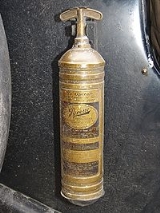
Carbon tetrachloride
Overview
Organic compound
An organic compound is any member of a large class of gaseous, liquid, or solid chemical compounds whose molecules contain carbon. For historical reasons discussed below, a few types of carbon-containing compounds such as carbides, carbonates, simple oxides of carbon, and cyanides, as well as the...
with the formula
Chemical formula
A chemical formula or molecular formula is a way of expressing information about the atoms that constitute a particular chemical compound....
CCl4. It was formerly widely used in fire extinguisher
Fire extinguisher
A fire extinguisher or extinguisher, flame entinguisher is an active fire protection device used to extinguish or control small fires, often in emergency situations...
s, as a precursor to refrigerant
Refrigeration
Refrigeration is a process in which work is done to move heat from one location to another. This work is traditionally done by mechanical work, but can also be done by magnetism, laser or other means...
s, and as a cleaning agent
Cleaning agent
Cleaning agents are substances, usually liquids, that are used to remove dirt, including dust, stains, bad smells, and clutter on surfaces. Purposes of cleaning agents include health, beauty, absence of offensive odor, avoidance of shame, and avoidance of spreading of dirt and contaminants to...
. It is a colourless liquid with a "sweet" smell that can be detected at low levels.
Both carbon tetrachloride and tetrachloromethane are acceptable names under IUPAC nomenclature
IUPAC nomenclature
A chemical nomenclature is a set of rules to generate systematic names for chemical compounds. The nomenclature used most frequently worldwide is the one created and developed by the International Union of Pure and Applied Chemistry ....
.
The production of carbon tetrachloride has steeply declined since the 1980s due to environmental concerns and the decreased demand for CFC
Haloalkane
The haloalkanes are a group of chemical compounds derived from alkanes containing one or more halogens. They are a subset of the general class of halocarbons, although the distinction is not often made. Haloalkanes are widely used commercially and, consequently, are known under many chemical and...
s, which were derived from carbon tetrachloride.
Unanswered Questions

